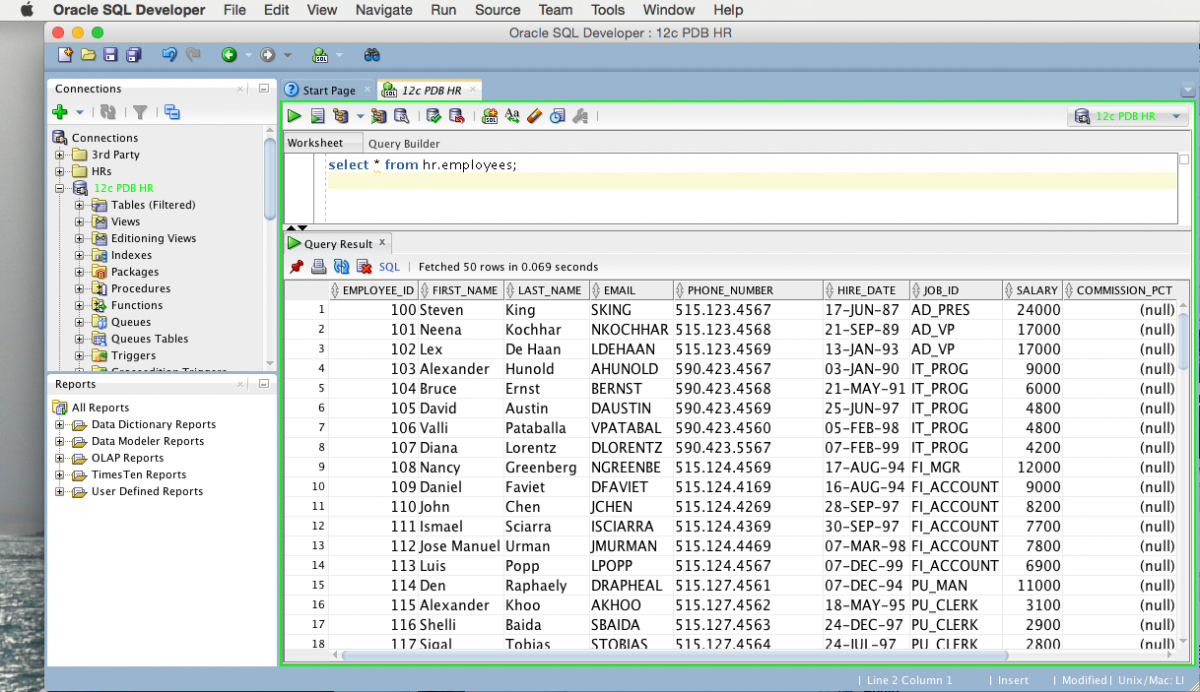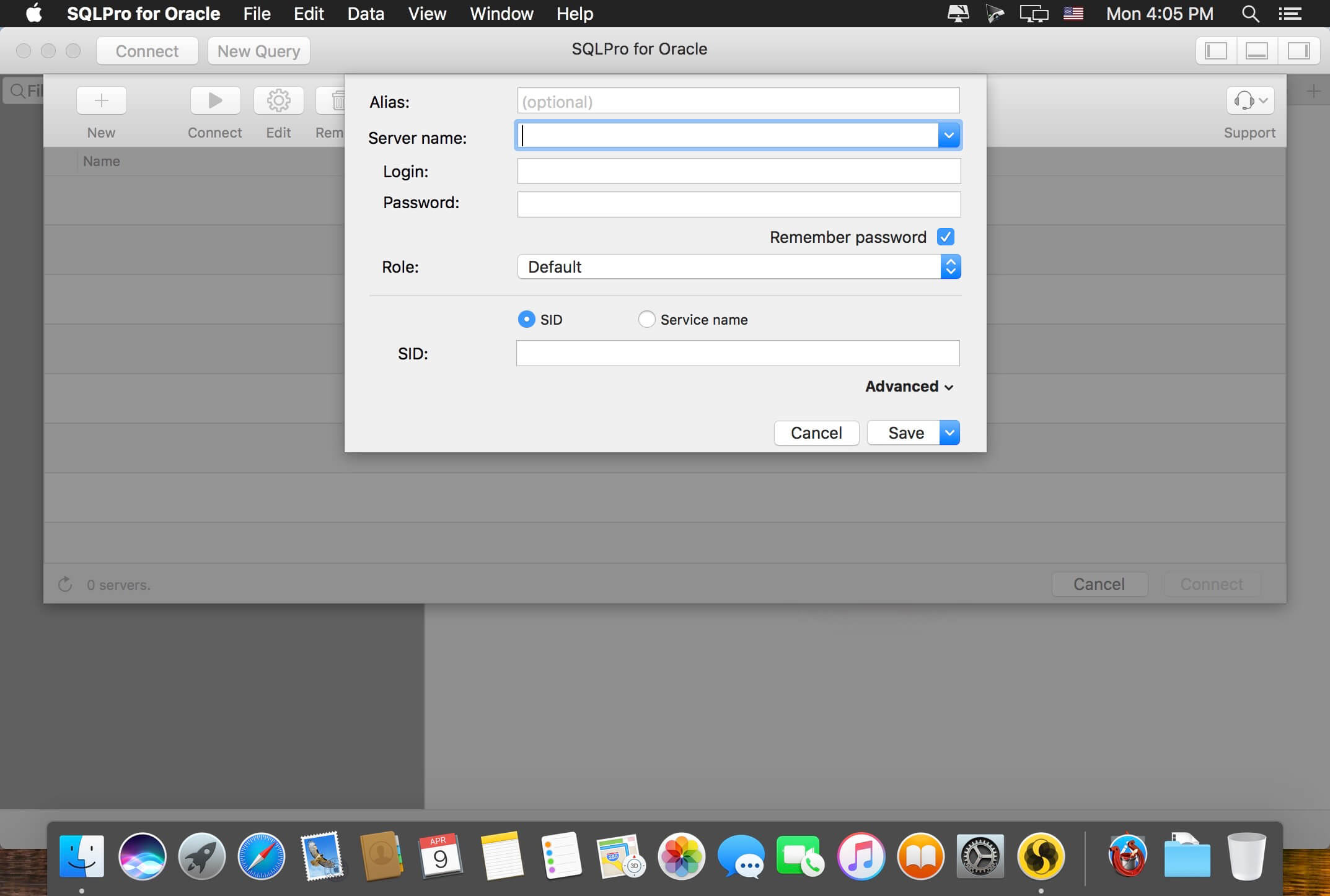Oracle Database 10g Release 2, Oracle SQL Developer, and Oracle JDeveloper are fully certified on Mac OS X. Turn your Mac into a full-fledged development environment and deploy Xserve-based grids.
See JDK 7 and JRE 7 Installation Guide for general information about installing JDK 7 and JRE 7.
See the Mac OS X Platform Install FAQ for general information about installing JRE 7 on Mac OS X.
Contents
System Requirements
- Any Intel-based Mac running Mac OS X 10.7.3 (Lion) or later.
- Administrator privileges.
Note that installing the JRE on a Mac is performed on a system wide basis, for all users, and administrator privileges are required. You cannot install Java for a single user.
Only one JRE can be installed at a time. The system will not install a JRE that has a lower version than the current version. If you wish to install a lower version of the JRE, first uninstall the current version. Installing a JRE from Oracle will not update java -version symlinks or add java to your path. To be able to do this, you need to install the JDK.JRE 7 Installation Instructions
The JRE installation includes the JavaFX Runtime which is incorporated into the same directory structure.
Installation of the 64-bit JRE on Mac Platforms
Depending on your processor, the downloaded file has one of the following names:
- jre-7u<version>-macosx-amd64.dmg
- jre-7u<version>-macosx-x64.dmg
Where <version> is 6 or later.
1. Download the file. Before the file can be downloaded, you must accept the license agreement.
2. From either the Downloads window of the browser, or from the file browser, double click the .dmg file to launch it.

3. A Finder window appears containing an icon of an open box and the name of the .pkg file Double click the package icon to launch the Install app.
4. The Install app displays the Introduction window. Click Continue.
4a. Note that, in some cases, a Destination Select window appears. This is a bug, as there is only one option available. If you see this window, select Install for all users of this computer to enable the continue button. Click Continue.
5. The Installation Type window appears. Click Install.
6. A window appears which says 'Installer is trying to install new software. Type your password to allow this.' Enter the Administrator login and password and click Install Software.
7. The software is installed and a confirmation window appears.
After the software is installed, delete the dmg file if you want to save disk space.
Determining the Installed Version of the JRE
If you have not yet installed Apple's Java Mac OS X 2012-006 update, then you are still using a version of Apple Java 6 that includes the plug-in and the Java Preferences app. See Note for Users of Macs that Include Apple Java 6 Plug-in.Only one JRE can be installed. Installing a JRE removes the previously installed JRE. The JRE version used by the system can be determined in one of two ways:

- From System Preferences click the Java icon from the Other category. This launches the Java Control Panel. Click About....
- Type the following in a Terminal window:
The system will not install a JRE that has a lower version than the current version. If you want to install a lower version, first uninstall the existing version.
Uninstalling the JRE
Oracle For Macbook
To uninstall the JRE, you must have Administrator privileges and execute the remove commands either as root or by using the sudo(8) tool.
Remove one directory and one file (a symlink), as follows:
- Navigate to /Library/Internet Plug-Ins and remove the JavaAppletPlugin.plugin directory.
- Navigate to /Library/PreferencePanes and remove JavaControlPanel.prefpane.
Do not attempt to uninstall Java by removing the Java tools from /usr/bin. This directory is part of the system software and any changes will be reset by Apple the next time you perform an update of the OS.
- Class
Class Mac
- javax.crypto.Mac
- All Implemented Interfaces:
- Cloneable
This class provides the functionality of a 'Message Authentication Code' (MAC) algorithm.A MAC provides a way to check the integrity of information transmitted over or stored in an unreliable medium, based on a secret key. Typically, message authentication codes are used between two parties that share a secret key in order to validate information transmitted between these parties.
A MAC mechanism that is based on cryptographic hash functions is referred to as HMAC. HMAC can be used with any cryptographic hash function, e.g., SHA256 or SHA384, in combination with a secret shared key. HMAC is specified in RFC 2104.
Every implementation of the Java platform is required to support the following standard
Macalgorithms:- HmacMD5
- HmacSHA1
- HmacSHA256
- Since:
- 1.4
Constructor Summary
Constructors Modifier Constructor and Description protectedMac(MacSpi macSpi, Provider provider, String algorithm)
Method Summary
Methods Modifier and Type Method and Description Objectclone()Returns a clone if the provider implementation is cloneable.byte[]doFinal()byte[]doFinal(byte[] input)Processes the given array of bytes and finishes the MAC operation.voiddoFinal(byte[] output, int outOffset)StringgetAlgorithm()Returns the algorithm name of thisMacobject.static MacgetInstance(String algorithm)Returns aMacobject that implements the specified MAC algorithm.static MacgetInstance(String algorithm, Provider provider)Returns aMacobject that implements the specified MAC algorithm.static MacgetInstance(String algorithm, String provider)Returns aMacobject that implements the specified MAC algorithm.intgetMacLength()ProvidergetProvider()Returns the provider of thisMacobject.voidinit(Key key)voidinit(Key key, AlgorithmParameterSpec params)Initializes thisMacobject with the given key and algorithm parameters.voidreset()voidupdate(byte input)Processes the given byte.voidupdate(byte[] input)voidupdate(byte[] input, int offset, int len)Processes the firstlenbytes ininput, starting atoffsetinclusive.voidupdate(ByteBuffer input)Processesinput.remaining()bytes in the ByteBufferinput, starting atinput.position().Methods inherited from class java.lang.Object
equals, finalize, getClass, hashCode, notify, notifyAll, toString, wait, wait, wait
Oracle Database For Mac
Constructor Detail
Mac
- Parameters:
macSpi- the delegateprovider- the provideralgorithm- the algorithm
Method Detail
getAlgorithm
Returns the algorithm name of thisMacobject.This is the same name that was specified in one of the
getInstancecalls that created thisMacobject.- Returns:
- the algorithm name of this
Macobject.
getInstance
Returns aMacobject that implements the specified MAC algorithm.This method traverses the list of registered security Providers, starting with the most preferred Provider. A new Mac object encapsulating the MacSpi implementation from the first Provider that supports the specified algorithm is returned.
Note that the list of registered providers may be retrieved via the
Security.getProviders()method.- Parameters:
algorithm- the standard name of the requested MAC algorithm. See the Mac section in the Java Cryptography Architecture Standard Algorithm Name Documentation for information about standard algorithm names.- Returns:
- the new
Macobject. - Throws:
NoSuchAlgorithmException- if no Provider supports a MacSpi implementation for the specified algorithm.- See Also:
Provider
getInstance
Returns aMacobject that implements the specified MAC algorithm.A new Mac object encapsulating the MacSpi implementation from the specified provider is returned. The specified provider must be registered in the security provider list.
Note that the list of registered providers may be retrieved via the
Security.getProviders()method.- Parameters:
algorithm- the standard name of the requested MAC algorithm. See the Mac section in the Java Cryptography Architecture Standard Algorithm Name Documentation for information about standard algorithm names.provider- the name of the provider.- Returns:
- the new
Macobject. - Throws:
NoSuchAlgorithmException- if a MacSpi implementation for the specified algorithm is not available from the specified provider.NoSuchProviderException- if the specified provider is not registered in the security provider list.IllegalArgumentException- if theprovideris null or empty.- See Also:
Provider
getInstance
Returns aMacobject that implements the specified MAC algorithm.A new Mac object encapsulating the MacSpi implementation from the specified Provider object is returned. Note that the specified Provider object does not have to be registered in the provider list.
- Parameters:
algorithm- the standard name of the requested MAC algorithm. See the Mac section in the Java Cryptography Architecture Standard Algorithm Name Documentation for information about standard algorithm names.provider- the provider.- Returns:
- the new
Macobject. - Throws:
NoSuchAlgorithmException- if a MacSpi implementation for the specified algorithm is not available from the specified Provider object.IllegalArgumentException- if theprovideris null.- See Also:
Provider
getProvider
- Returns:
- the provider of this
Macobject.
getMacLength
Returns the length of the MAC in bytes.- Returns:
- the MAC length in bytes.
init
- Parameters:
key- the key.- Throws:
InvalidKeyException- if the given key is inappropriate for initializing this MAC.
init
Initializes thisMacobject with the given key and algorithm parameters.- Parameters:
key- the key.params- the algorithm parameters.- Throws:
InvalidKeyException- if the given key is inappropriate for initializing this MAC.InvalidAlgorithmParameterException- if the given algorithm parameters are inappropriate for this MAC.
update
- Parameters:
input- the input byte to be processed.- Throws:
IllegalStateException- if thisMachas not been initialized.
update
Processes the given array of bytes.- Parameters:
input- the array of bytes to be processed.- Throws:
IllegalStateException- if thisMachas not been initialized.
update
Processes the firstlenbytes ininput, starting atoffsetinclusive.- Parameters:
input- the input buffer.offset- the offset ininputwhere the input starts.len- the number of bytes to process.- Throws:
IllegalStateException- if thisMachas not been initialized.
update
Processesinput.remaining()bytes in the ByteBufferinput, starting atinput.position(). Upon return, the buffer's position will be equal to its limit; its limit will not have changed.- Parameters:
input- the ByteBuffer- Throws:
IllegalStateException- if thisMachas not been initialized.- Since:
- 1.5
doFinal
Finishes the MAC operation.A call to this method resets this
Macobject to the state it was in when previously initialized via a call toinit(Key)orinit(Key, AlgorithmParameterSpec). That is, the object is reset and available to generate another MAC from the same key, if desired, via new calls toupdateanddoFinal. (In order to reuse thisMacobject with a different key, it must be reinitialized via a call toinit(Key)orinit(Key, AlgorithmParameterSpec).- Returns:
- the MAC result.
- Throws:
IllegalStateException- if thisMachas not been initialized.
doFinal
Finishes the MAC operation.A call to this method resets this
Macobject to the state it was in when previously initialized via a call toinit(Key)orinit(Key, AlgorithmParameterSpec). That is, the object is reset and available to generate another MAC from the same key, if desired, via new calls toupdateanddoFinal. (In order to reuse thisMacobject with a different key, it must be reinitialized via a call toinit(Key)orinit(Key, AlgorithmParameterSpec).The MAC result is stored in
output, starting atoutOffsetinclusive.- Parameters:
output- the buffer where the MAC result is storedoutOffset- the offset inoutputwhere the MAC is stored- Throws:
ShortBufferException- if the given output buffer is too small to hold the resultIllegalStateException- if thisMachas not been initialized.
doFinal
Processes the given array of bytes and finishes the MAC operation.A call to this method resets this
Macobject to the state it was in when previously initialized via a call toinit(Key)orinit(Key, AlgorithmParameterSpec). That is, the object is reset and available to generate another MAC from the same key, if desired, via new calls toupdateanddoFinal. (In order to reuse thisMacobject with a different key, it must be reinitialized via a call toinit(Key)orinit(Key, AlgorithmParameterSpec).- Parameters:
input- data in bytes- Returns:
- the MAC result.
- Throws:
IllegalStateException- if thisMachas not been initialized.
reset
Resets thisMacobject.A call to this method resets this
Macobject to the state it was in when previously initialized via a call toinit(Key)orinit(Key, AlgorithmParameterSpec). That is, the object is reset and available to generate another MAC from the same key, if desired, via new calls toupdateanddoFinal. (In order to reuse thisMacobject with a different key, it must be reinitialized via a call toinit(Key)orinit(Key, AlgorithmParameterSpec).
clone
Returns a clone if the provider implementation is cloneable.- Overrides:
clonein classObject- Returns:
- a clone if the provider implementation is cloneable.
- Throws:
CloneNotSupportedException- if this is called on a delegate that does not supportCloneable.- See Also:
Cloneable
- Class
- Summary:
- Nested |
- Field |
- Constr |
- Detail:
- Field |
- Constr |
Toad Oracle For Mac
Submit a bug or feature
For further API reference and developer documentation, see Java SE Documentation. That documentation contains more detailed, developer-targeted descriptions, with conceptual overviews, definitions of terms, workarounds, and working code examples.
Copyright © 1993, 2018, Oracle and/or its affiliates. All rights reserved. Use is subject to license terms. Also see the documentation redistribution policy.
Oracle For Mac Download
Scripting on this page tracks web page traffic, but does not change the content in any way.